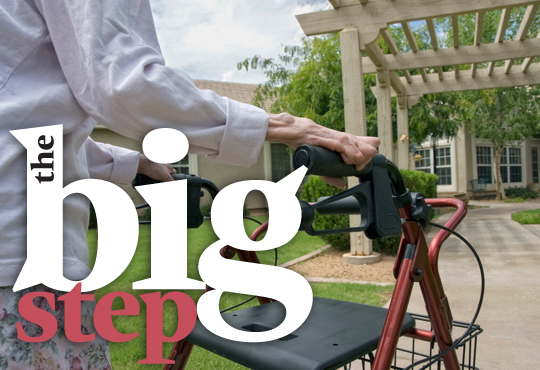
Canadians now live an average of nearly two decades past their 65th birthday, often forcing boomer generation kids and aging spouses to make the heart-wrenching decision to place a loved one in residential care …
Wendy and Terry L. are faced with that tough reality. Terry’s mom, Mary, can no longer take care of herself. She is 86 years old, losing her sight to macular degeneration and is now beginning to show signs of dementia.
Widowed in 2006, Wendy and Terry brought her to live with them, but their three-storey house was no place for a woman with failing eyesight, so Mary moved into Fernbrae Manor, an assisted living facility in Kelowna. However, vision wasn’t Mary’s only problem. Not an outgoing person at the best of times, she had depended on her husband for social contact. Without him she became a recluse and depressed, rarely bathing or leaving her apartment. Her doctor put her on antidepressants.
Again assessing the situation, Wendy and Terry returned to the idea of having Mary live with them. In spite of the fact that they still have two daughters living at home and, being in their 50s, are trying to save for retirement, they moved to a more elder-friendly house and poured money into renovations such as exterior ramps to replace stairs and grab bars in the bathroom.
Yet the simple solution of having mom move in with them hasn’t worked out to be that simple. The meds the doctors prescribed for depression started to react with the medicine for macular degeneration, causing dizzy spells. These eventually led to a fall that resulted in a serious gash over her eye and a broken arm and wrist. Adding to the stress, Mary began wandering at night and showing early signs of dementia.
“After $25,000 in renovations to make the new house safe and easy to live in for her, we’ve come to the conclusion that Mary just cannot look after herself,” says Wendy. “But we didn’t know what to ask at first. I don’t think our family doctor did a very thorough assessment.”
Wendy thought they should hire a nurse through a private company. But the price tag of $25 to $30 an hour was beyond the family budget. Then she learned of the services provided by the Interior Health Authority (IHA), which also controls placement in care facilities. Things started to happen almost immediately. The first step was assessment by an IHA home and community care health professional to determine what services Mary would be eligible for. It will still take four to six months or more before a bed can be found in residential care, but in the meantime programs are available to make life easier.
Mary was assigned a care aid who comes in once a week to bathe her and to make sure she changes her clothing. This is a no-cost service. In addition, respite services can take Mary into care for a maximum of four days at a time and up to 30 days per year. If Wendy and Terry want to head to Vancouver for a long weekend, Mary can be placed in a safe and caring environment for less than $120 in total.
“Interior Health is great and the people there are awesome,” says Wendy. “Where everything bogs down is with the paperwork involved in getting things done.”
Collateral Damage
A skeleton in the closet of senior care is the collateral damage caused when a parent or spouse must be placed in care. Terry is suffering anxiety attacks caused by the frustration of the situation. His conflict is that his mom still has good days and on those days he doesn’t see the need to place her in a home yet.
Terry’s feelings are common among the children of aging parents. But the pain can be even more severe for a spouse who must put his loved one “away.”
Jim and Barb recently celebrated their 60th anniversary. The party was wonderful. Jim, who lives on his own in a seniors’ residence, arranged dinner for a dozen friends and relatives. He brought Barb to the party from her full-time care facility. When the evening wrapped up with Jim singing to his wife, there wasn’t a dry eye in the house.
What people didn’t see was how much the separation was tearing him apart.
Jim has stood by his wife and cared for her as her once-sharp mind withered with dementia. He knows intellectually that she will never recover, but at times loses sight of the fact emotionally.
Both are retired educators who moved from Ontario to spend what they thought would be their golden years in the Okanagan. But Barb began to exhibit subtle symptoms that Jim recognizes now as the early onset of the disease. She refused to go anywhere although travel was part of their strategy. She declared the kitchen her private preserve, then wouldn’t cook. Housekeeping went much the same way. Barb’s stories became repetitive and she began to dwell on her childhood years.
Like Wendy and Terry, Jim feels his family doctor was slow to pick up on the symptoms. But that was an indicator of his own state of mind. His personal dream was happily growing old together with his wife—a Norman Rockwell portrait of aging. They would enjoy each other’s company, travel and spend time with their grandchildren.
As the dream slipped away, Jim buried himself in activity. He went hiking and fishing and spent hours in the workshop making toys and furniture. At one point he built an exquisite model of a gunpowder mill that he donated to the museum in an English village near where his ancestors hailed from.
“I was one of those guys who didn’t need all the touchy-feely stuff,” Jim says. “I was tough enough to deal with it on my own. Or at least that’s what I thought until I couldn’t take it anymore.”
A friend recommended an IHA support group. At first Jim thought it was “a load,” then he understood the need to unburden to other people who were undergoing the same gut-wrenching changes in their lives. He’s still part of the support group although his attendance goes up and down with his personal needs.
Nearly four years on, Jim still struggles with his conscience, because on good days he believes he could look after Barb at home. He says the toughest day of his life was the day he had to place her in care.
“I knew that she wouldn’t be coming out, but she didn’t. I had to lie to her about the clothes I was packing. She was OK until we got to the home. Once we knew she was going in, I took pictures and personal mementoes over and decorated her room. When she saw them she suddenly realized what was going on and I had to leave. I couldn’t take it.”
Caring Facilities
The couple was lucky enough to have a space open up in the Village at Smith Creek. The residence, described by one psychiatrist as the Cadillac of homes in the Valley, was within walking distance of Jim’s place in West Kelowna. Some people are not so lucky. They’re stuck kilometres away requiring family members to undertake a major expedition even for a small visit.
You can request a specific residence, but there’s no guaranty that’s where your loved one will be placed. IHA asks families to choose at least two facilities in order of preference. When a bed becomes available, the decision to accept routinely has to be made within 24 hours. Authorities tell families that they should take the first bed available then arrange a transfer, but transfers can take a year or more. The family is under tremendous pressure from all sides.
But people in the Okanagan are fortunate in the overall quality of facilities. Over the years, the philosophy regarding nursing homes (now known as residential care facilities) has changed radically. Administrators no longer run warehouses for seniors. A new generation of administrators recognizes the fact that their operations must provide a home-like environment for residents.
One of the most respected operators in the Valley is the Baptist Housing Authority, which operates three multi-level residences including the Village at Smith Creek (VSC). Manager Karen Wasden is a poster girl for the new ideal. Facilities like VSC are multi-level operations that provide independent and assisted living along with residential care. Residents are encouraged to treat VSC as their home.
Karen is a registered nurse who found her calling here. “We get attached to the residents, but you’ve got to remember that this is the final home for many of these people, so relationships are shorter, but no less intense. When we lose a resident everyone takes it hard and there are a lot of tears. Some of the staff need help getting over the loss.”
Before entering VSC, residents are eased into their new environment if at all possible. They can take part in Elder Well (a kind of day camp for seniors), stay over during respite care and are encouraged to visit.
Operations like VSC also try to connect with the spouses and families of residents. Family members volunteer, helping to serve meals, gardening and joining in as companions on day trips to shop, see a movie or just have a day out.
In spite of his struggle to deal with Barb’s placement, Jim sings with the informal choir and works alongside the staff. Out back, the flower garden he planted to please Barb, brings joy to everyone in her unit. And even if this isn’t the future he envisioned for them, at least it provides some comfort that they can be together as much as possible in a home-like environment.
Maybe seeing an example like Jim’s will help Terry and others like him when they too are forced to take the big step.
Tips to ease the big step
1. Don’t think that you can handle an aging parent or spouse by yourself. Discuss with your doctor whether or not your loved one is capable of living independently for the foreseeable future. If the answer is no, contact the Interior Health Authority (IHA) right away for assessment and “get into the system.”
www.interiorhealth.ca/HomeCommunityCare.aspx
2. Don’t wait. Begin preparations well in advance of the time for the move. Take your loved one to Elder Day Care or Elder Well so they can take part in extra-curricular programs. Let them visit several facilities that you think might suit them.
3. Assess the homes you visit with your eyes and nose. Are common areas comfortable and well used? Is the air fresh or does it smell of soiled adult diapers?
4. Meet the staff at any prospective home, not just the marketing manager.
5. Make use of home help services provided by IHA (or private companies if that option is financially feasible).
6. Get financial advice. Fees are determined by the resident’s income. Be prepared to pay up to 80 per cent of your loved one’s after tax income (tax statements are used to calculate the final cost). This can have unexpected consequences. For example, if a man and wife live off the man’s pension, she (never having worked) has no income of her own to speak of. If the man goes into care before his wife, the wife can be left with virtually nothing to live on because IHA bases the fee calculation on his income.
7. Decorate your loved one’s space and make it feel as homey as possible. This will go a long way toward their comfort and happiness and your peace of mind.
8. Volunteer. Lifting a little of the load gives staff more time to provide needed care and builds important relationships. It also gives you something to do when visiting your loved one.
9. Look after yourself. Go to counselling. You may not feel you need it, but you’re not necessarily the best judge. Start getting help long before you actually have to take the big step. When you need a mental health day, take it. Don’t let your emotions get the best of you. It’s hard on everyone, but try to understand that you’re not abandoning your loved one—you’re arranging the best possible care.
By Bruce Kemp



0 Comments